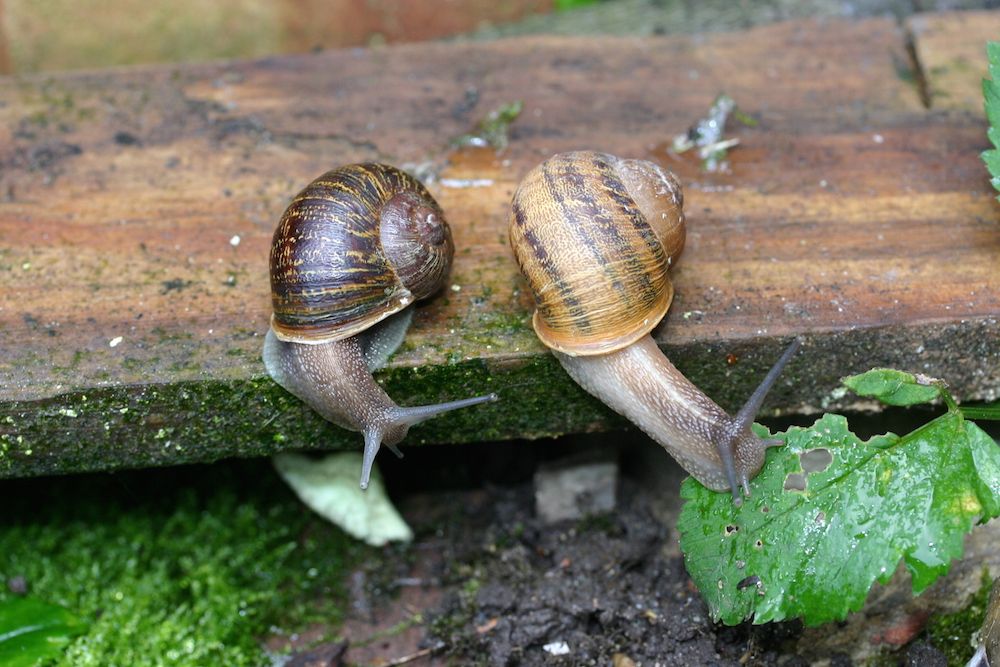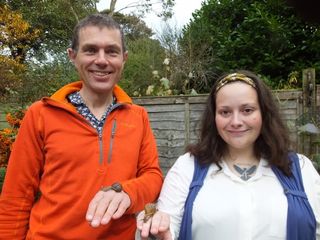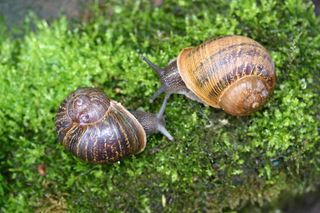Love at Last! Rare 'Lefty' Snail Finds Mollusk Mate

Jeremy, a snail with a rare left-spiraling shell, is lonely no more. After a vast media campaign designed to help the mollusk find a left-spiraled mate, two matches have oozed forward, in a manner of speaking.
The double discovery astonished Jeremy's keeper, Angus Davison, an associate professor and reader in evolutionary genetics at the University of Nottingham's School of Life Sciences.
"I was amazed — not one but two potential mates," Davison told Live Science in an email. "Our 'citizen science' appeal has worked." [Amazing Mollusks: Images of Strange & Slimy Snails]
Davison has a long history with Jeremy. A retired colleague gave Davison the garden snail (Cornu aspersum) after finding it in a compost heap in Raynes Park in southwest London. Jeremy's rare left-spiraling, or sinistral, shell intrigued Davison, prompting him to study the genetics behind the rare twist, he said.

In March 2016, Davison and his colleagues published a study in the journal Current Biology, announcing that they had "discovered a gene that determines whether a snail's shell twists in a clockwise or anti-clockwise direction," he said.
"The same gene also affects body asymmetry in other animals — including possibly humans," Davison continued. "Research using these snails could offer the chance to develop our understanding of how organs are placed in the body, and why this process can sometimes go wrong when some or all of the major internal organs are reversed from their normal placement."
But it remains a mystery whether a sinistral shell is inherited or simply a developmental glitch. Moreover, Davison realized that he couldn't solve this mystery unless Jeremy mated with another lefty snail. That's because Jeremy would find it extremely challenging to mate with a righty snail.
Sign up for the Live Science daily newsletter now
Get the world’s most fascinating discoveries delivered straight to your inbox.
When snails are ready to reproduce, they face each other. "Imagine two cars passing each other, driving in opposite directions," Davison told Live Science in October, when he began the #SnailLove media campaign to find Jeremy a sinestral mate. "As long as they have their steering wheels on the same side, then they can pass a package between them, across the middle of the road. But if one has the [driving wheel] on the other side, it won't work."
What's more, snails are hermaphrodites, meaning that they can reproduce on their own if necessary. But snails usually prefer to mate with other snails, and such a match would help researchers learn more about how Jeremy's one-in-a-million shell came to be, Davison said.
Mollusk matches

Not long after the campaign began, Davison heard from two snail enthusiasts. The first, Jade Sanchez Melton from Ipswich in southeast England, keeps about 300 snails in her house.
"She found 'Lefty' last year and recognized it as special, knowing also that it would struggle to find a mate," Davison said. "So, when she heard about our appeal, she was straight in touch with us."
The other enthusiast, Miguel Àngel Salom, is a snail farmer and restaurateur in Majorca, Spain. "A few days after our appeal went out, he found 'Tomeu' in some snails that he was cleaning, and saved him/her from the pot," Davison said.
Jeremy has yet to meet Tomeu, but he's had some romantic time with Lefty.
"They have been seen flirting — generally crawling over one another, gentle biting, but no mating yet," Davison said.
If Jeremy does mate, it's unclear when the babies would arrive. Snails usually lay eggs within a week or two of mating, but they can store sperm for as long as a year, Davison said. Once the eggs are fertilized, snails usually lay between 40 and 60 at once in the soil, he said.
Original article on Live Science.

Laura is the archaeology and Life's Little Mysteries editor at Live Science. She also reports on general science, including paleontology. Her work has appeared in The New York Times, Scholastic, Popular Science and Spectrum, a site on autism research. She has won multiple awards from the Society of Professional Journalists and the Washington Newspaper Publishers Association for her reporting at a weekly newspaper near Seattle. Laura holds a bachelor's degree in English literature and psychology from Washington University in St. Louis and a master's degree in science writing from NYU.









